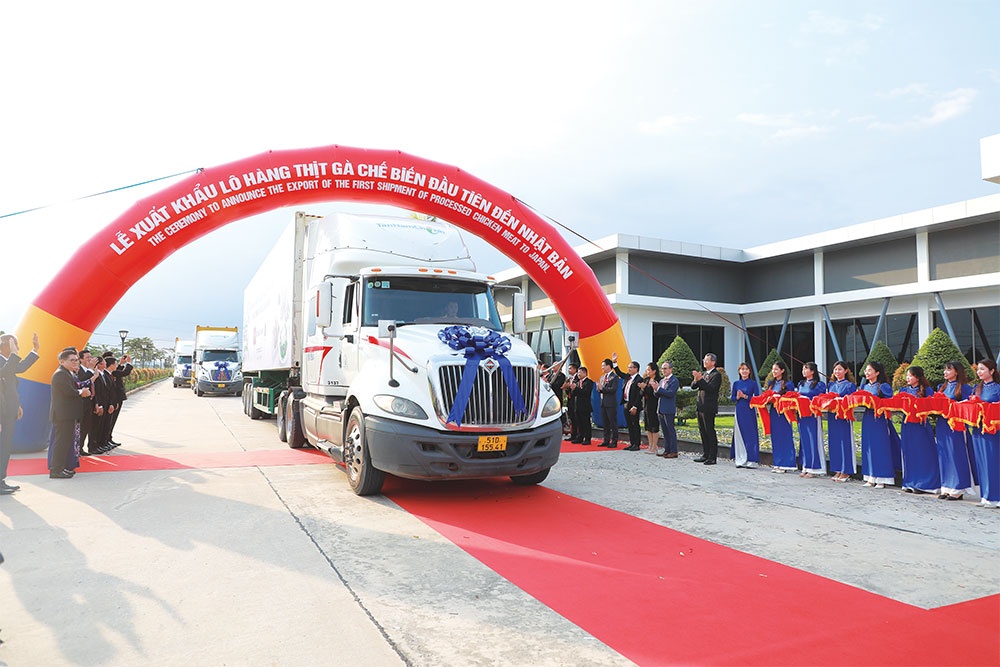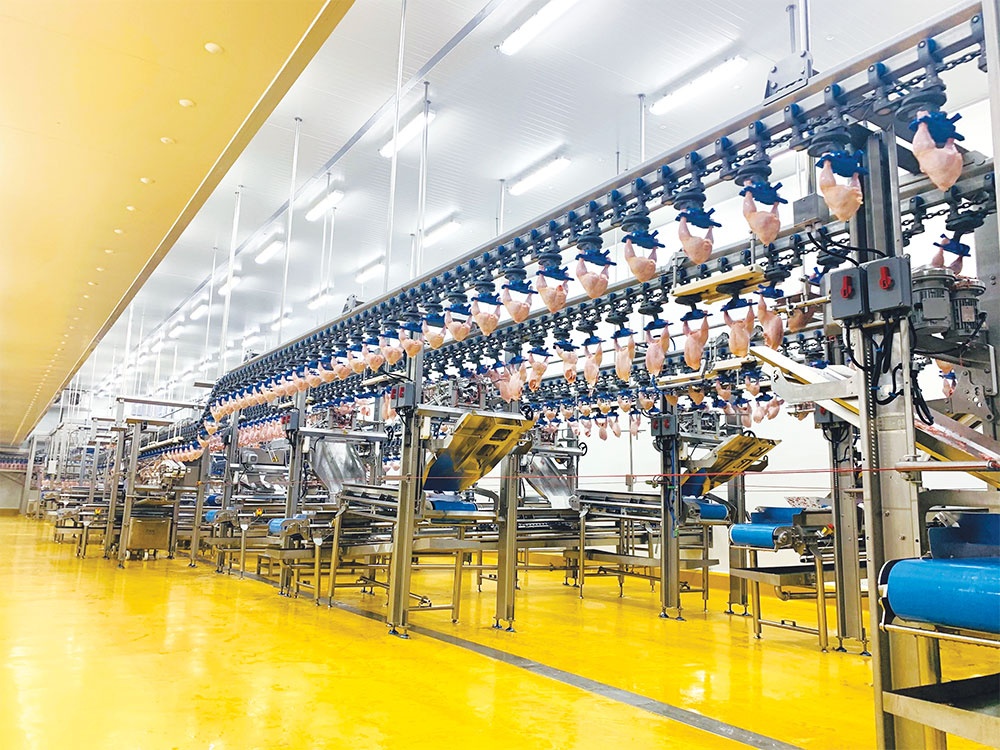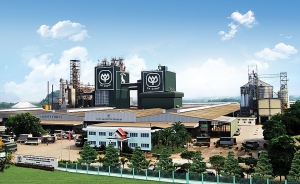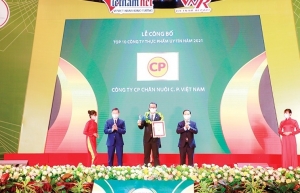CPV Food entering new frontiers
Last week, CPV Food, based in the southern province of Binh Phuoc and a subsidiary of Thailand’s C.P. Vietnam (CPV), announced the export of the first shipment of 33 tonnes of processed chicken to Japan, and received a health certificate from the Department of Animal Health.
 |
Montri Suwanposri, CPV president, said, “We are happy and honoured to export the first shipment of processed chicken to Japan, marking the success of the feed-farm-food chain of CPV and starting the roadmap of getting our processed chicken to Japan and other markets in Europe, Asia, and the Middle East.”
If successful, CPV hopes to become a pioneering firm in establishing a processed poultry meat export ecosystem in Vietnam, thus affirming the position of the nation’s food processing industry, Suwanposri added.
The enclosed processed chicken meat chain is expected to contribute to the export values of the country and create thousands of jobs for local people in Binh Phuoc. “This contributes to implementing a target of ours to pay tribute to the Vietnamese nation,” he said.
Deputy Minister of Agriculture and Rural Development Phung Duc Tien noted that Japan is the world’s third-largest importer of chicken meat, following China and Russia. Japan needs to import one million tonnes of chicken meat, while CPV has the most modern hatchery and processing factory in Vietnam, with a capacity of 50 million broilers per year in the first phase and 100 million in the second phase. “There are plenty of opportunities for CPV, and the husbandry industry in general, to take their food to Japan and other markets,” emphasised Tien.
The Japanese market is one of the most promising destinations for numerous businesses to export high-quality items. To set foot in Japan, CPV Food must ensure the traceability of the whole supply chain from materials to food processing and prove world-class manufacturing practices – including environmental and animal welfare – to meet the strict standards of Japan as well as other developed countries. Previously, the Japanese Ministry of Agriculture, Forestry, and Fisheries sent a veterinary inspection team to CPV Food’s production facility in Binh Phuoc to evaluate the production chain of processed chicken for export.
 |
| C.P. Vietnam’s meticulous processes ensure quality, freshness, and safety |
CPV Food’s factory was inaugurated in 2020 with investment capital of $250 million. Last year, CPV Food exported over 215 tonnes of processed chicken meat and, in the first eight months of this year, the company shipped 442 tonnes to Hong Kong and Laos.
In addition to CPV, some other players are boosting investment into husbandry and processing to export their products, such as VietSwan in Binh Duong province, Koyu and Unitek in Ba Ria-Vung Tau province, and QL Vietnam Agro Resourses in Tay Ninh province.
Developing biosecurity zones is contributing to exporting chicken and other poultry. Binh Phuoc People’s Committee, in collaboration with the Ministry of Agriculture and Rural Development and its Department of Animal Health, has been building biosecurity chains and zones in the province for exporting meat. To date, around 960 poultry breeding facilities in the southeast region are certificated for biosecurity.
| The feed-farm-food process from C.P. Vietnam Strategically located within one of only five Binh Phuoc province approved biosecurity zones, CPV’s integrated feed-farm-food production is conveniently connected to Vietnam and the world. At CPV’s feed mill, only the best selection of quality, fresh, and clean raw materials, which have passed a rigorous inspection, make it into CPV’s feed production process. Mixing, thermal conditioning, and cooling are conducted in an automated, modern, and enclosed way to minimise contamination. Animal feed from every mill meets the highest standard of product quality and consistency and all feed is thoroughly inspected before being loaded in specially designed compartment feed trucks. CPV imports great breeder genes from great-grandparent stock, grandparent stock, and parent stock levels, ensuring that chickens maintain good shape and large structure, while strong and naturally fast-growing chicks are obtained without the use of hormones. The farm layout is zoned into the inner and outer farm areas to minimise risks of contamination. Poultry are in a completely enclosed and fully automated evaporated glee housing unit. Hatched eggs are then transported by air-conditioned trucks in accordance with HACCP standards to ensure that all hatched eggs are in good health and disease-free. Upon arrival at the hatchery, eggs are first fumigated and/or oxidised, inspected, and sorted. The fully automated hatchery uses state-of-the-art technology to control temperature, airflow, and moisture at every stage. Most notably, CPV Food’s factory in Binh Phuoc will be the first in Asia to implement in-shell vaccination. Broilers are also raised in a completely enclosed and fully automated evaporated glee housing unit with an evaporative cooling system which helps to control the temperature inside the house. While a water mat feature installed at each house helps to maintain the air and temperature condition of the house. Additionally, the sound of the running water helps to keep the broilers calm as per animal welfare standards. The smart farm system enables data collection of water and feed intake, as well as broilers’ weight and temperature, throughout the culture period. All data can be analysed at any time to improve farm management for maximum efficiency. Staff can even inspect and monitor the health of the broilers in the farm without having to enter the house. CPV strictly adheres to the European standards of animal welfare by ensuring that broilers have ample space of 22-44kgs per square metre, or between about 11-25 birds per sq.m for the broilers’ welfare and wellbeing. Poultry is handled with care to minimise stress throughout the entire culture period. GPS is used for the transport of poultry from farm to processing plant, ensuring full traceability. CP’s slaughterhouse and further processing factory adhere to production processes in accordance with the principles of GMP standards. It begins with the process of electrical stimulation which helps to maintain the quality, taste, and tenderness of the chicken meat and then slaughtered according to Halal methods. Next to the scalding pot, plucking is carried out and the fresh product is then conveyed to the automatic special cutting room, before being weighed and sorted by meat size, vacuum packed, and then conveyed through X-ray and metal detectors to ensure products are safe and free of any foreign matter. CP’s further process begins with the freshest raw ingredients and spices. All are properly stored at recommended storage temperatures, and properly zoned from any possible contaminates. The cooking lines include steam, fry, roast, and charcoal grill. Cooked products are immediately conveyed to the IQF set at -40 degrees Celsius to reduce the temperature of the product to -18 degrees, maintaining the taste, quality, and freshness of the product before going through the automatic weighing and packing machine. Delivery of fresh and cooked products via temperature-controlled vehicles to the domestic distribution point ensures products are safe from any contamination. |
 | CP Foods doubles investment in facilities in Vietnam and China Charoen Pokphand Foods (CP Foods) will invest nearly $1 billion in overseas plants as well as research and development this year, accelerating its pursuit of growth outside Thailand. |
 | Responsible actions earn C.P. Vietnam prime accolades Thailand’s C.P. Vietnam has been named the most reputable frozen food company for the second year in a row and has hit five consecutive years of being named in the top 10 for food reputation in the country. |
What the stars mean:
★ Poor ★ ★ Promising ★★★ Good ★★★★ Very good ★★★★★ Exceptional
 Tag:
Tag:
Related Contents
Latest News
More News
- Businesses ramp up production as year-end orders surge (December 30, 2025 | 10:05)
- Vietjet chairwoman awarded Labour Hero title (December 29, 2025 | 13:06)
- How to unlock ESG value through green innovation (December 29, 2025 | 10:03)
- AI reshapes media and advertising industry (December 29, 2025 | 08:33)
- FPT and GELEX sign deal to develop blockchain tech for global markets (December 29, 2025 | 08:29)
- Vietnam’s GDP forecast to grow by 9 per cent in 2026 (December 29, 2025 | 08:29)
- Women entrepreneurs are key to Vietnam’s economic growth (December 29, 2025 | 08:00)
- Vietnam's top 500 value-creating enterprises announced (December 27, 2025 | 08:00)
- The PAN Group shaping a better future with ESG strategy (December 26, 2025 | 09:00)
- Masan Consumer officially lists on HSX, marking the next phase of value creation (December 25, 2025 | 13:20)























 Mobile Version
Mobile Version